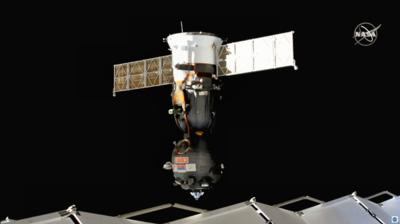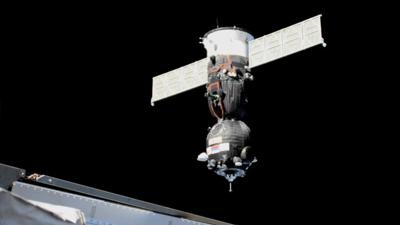Thu, Feb 11, 2021
Considering The Adding Of A Seat On The Spring Soyuz Mission to the ISS
A rotating crew of NASA and international astronauts have called the International Space Station home for more than 20 years. To ensure a consistent U.S. presence on the space station through the years, NASA has implemented safeguards to ensure crew transportation is always available.

NASA now is considering obtaining a supplemental seat on the upcoming spring Soyuz crew rotation mission for a NASA astronaut to add additional capability to the agency’s planning. The agency issued a public synopsis to identify all sources that potentially could provide the crew transportation service in the needed timeframe beyond the capability NASA already has in operation with the agency’s Commercial Crew Program.
NASA has been working with Boeing and SpaceX to provide safe and reliable crew transportation to and from the International Space Station. The recent success of NASA’s SpaceX Demo-2 mission and the launch and docking of the Crew-1 mission have been significant milestones in providing reliable transportation to the space station on American commercial spacecraft from American soil. The upcoming NASA’s SpaceX Crew-2 mission, as well as the second uncrewed flight test for Boeing’s Starliner demonstrate continued progress.
Securing an additional Soyuz seat assures the back-up capability of at least one U.S. crew member aboard the International Space Station in the event of a problem with either spacecraft. NASA is considering providing in-kind services for this supplemental crew transportation service, rather than an exchange of funds.

It has been NASA’s practice to fly mixed crews on spacecraft to ensure safe and continuous operations of the International Space Station. Due to operational constraints, crew members must fly to the station and return on the same spacecraft. The crew currently aboard the station (Kate Rubins and the Crew-1 astronauts) must return on Soyuz and Crew Dragon respectively in April/May. NASA’s SpaceX Crew-2 is expected to launch as planned April 20. However, if the mission launch is delayed or an event occurs while Crew-2 is in-orbit that requires a premature return, NASA risks not having a U.S. crew member aboard the International Space Station.
“At NASA, we have a phrase we use often – dissimilar redundancy. That’s NASA speak for saying we always have a back-up plan that ensures we have a path forward even if we encounter an issue with our initial approach,” said Robyn Gatens, acting director for the International Space Station at NASA Headquarters. “We look forward to the next crew rotation on NASA’s SpaceX Crew-2 mission, and we’re looking to ensure we can continue to maximize our use of the station and minimize any risk by flying a U.S. astronaut on the upcoming spring Soyuz by providing in-kind services.”
The space station has hosted 242 people and a variety of international and commercial spacecraft. Astronauts and cosmonauts have traveled to and from the orbiting laboratory in the Russian Soyuz spacecraft and NASA’s space shuttle until its retirement in 2011.
More News
Local Airport Advisory (LAA) A service available only in Alaska and provided by facilities that are located on the landing airport, have a discrete ground-to-air communication freq>[...]
Also: Cosmonaut Kicked Out, Airbus Scales Back, AF Silver Star, Russian A-60 Clobbered A Samaritan’s Purse humanitarian flight was hijacked on Tuesday, December 2, while atte>[...]
Aero Linx: Michigan Helicopter Association (MHA) The Michigan Helicopter Association (MHA) exists to bring together people who share an interest in helicopters, including private, >[...]
Also: Airbus Acquisition, USCG Helo Sniper, Remember Pearl Harbor, New Thunderbird 1 Gulfstream’s newest addition to its next-gen lineup, the super-midsize G300, is officiall>[...]
Also: Electra Goes Military, Miami Air Taxi, Hypersonics Lab, MagniX HeliStrom Amazon’s Prime Air drones are back in the spotlight after one of its newest MK30 delivery drone>[...]
 ANN's Daily Aero-Term (12.14.25): Local Airport Advisory (LAA)
ANN's Daily Aero-Term (12.14.25): Local Airport Advisory (LAA) Airborne 12.08.25: Samaritans Purse Hijack, FAA Med Relief, China Rocket Fail
Airborne 12.08.25: Samaritans Purse Hijack, FAA Med Relief, China Rocket Fail ANN's Daily Aero-Linx (12.15.25)
ANN's Daily Aero-Linx (12.15.25) Airborne 12.10.25: New Gulfstream, ATC Integrator, Outrageous FFZ User Fees
Airborne 12.10.25: New Gulfstream, ATC Integrator, Outrageous FFZ User Fees Airborne-NextGen 12.09.25: Amazon Crash, China Rocket Accident, UAV Black Hawk
Airborne-NextGen 12.09.25: Amazon Crash, China Rocket Accident, UAV Black Hawk




